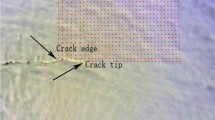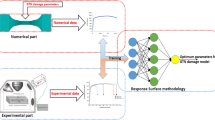Abstract
To study the influence of hydrogen on the fatigue strength of AISI type 304 metastable austenitic stainless steel, specimens were cathodically charged with hydrogen. Using tension-compression fatigue tests, the behavior of fatigue crack growth from a small drill hole in the hydrogen-charged specimen was compared with that of noncharged specimen. Hydrogen charging led to a marked increase in the crack growth rate. Typical characteristics of hydrogen effect were observed in the slip band morphology and fatigue striation. To elucidate the behavior of hydrogen diffusion microscopically in the fatigue process, the hydrogen emission from the specimens was visualized using the hydrogen microprint technique (HMT). In the hydrogen-charged specimen, hydrogen emissions were mainly observed in the vicinity of the fatigue crack. Comparison between the HMT image and the etched microstructure image revealed that the slip bands worked as a pathway for hydrogen to move preferentially. Hydrogen-charging resulted in a significant change in the phase transformation behavior in the fatigue process. In the noncharged specimen, a massive type α′ martensite was observed in the vicinity of the fatigue crack. On the other hand, in the hydrogen-charged specimen, large amounts of ε martensite and a smaller amount of α′ martensite were observed along the slip bands. The results indicated that solute hydrogen facilitated the ε martensitic transformation in the fatigue process. Comparison between the results of HMT and EBSD inferred that martensitic transformations as well as plastic deformation itself can enhance the mobility of hydrogen.














Similar content being viewed by others
References
D. Eliezer, D.G. Chakrapani, C.J. Altstetter, and E.N. Pugh: Metall. Trans. A, 1979, vol. 10A, pp. 935–41.
R. Liu, N. Narita, C. Altstetter, H. Birnbaum, and E.N. Pugh: Metall. Trans. A, 1980, vol. 11A, pp. 1563–74.
S. Singh and C. Altstetter: Metall. Trans. A, 1982, vol. 13A, pp. 1799–1808.
T.P. Perng and C.J. Altstetter: Acta Metall., 1986, vol. 34, pp. 1771–81.
T.P. Perng and C.J. Altstetter: Metall. Trans. A, 1987, vol. 18A, pp. 123–34.
Y. Murakami, T. Kanezaki, Y. Mine, and S. Matsuoka: Metall. Mater. Trans. A, 2008, vol. 39A, pp. 1327–39.
Y. Murakami and H. Matsunaga: Int. J. Fatigue, 2006, vol. 28, pp. 1509–20.
T. Kanezaki, C. Narazaki, Y. Mine, S. Matsuoka, and Y. Murakami: Int. J. Hydrogen Energy, 2008, vol. 33, pp. 2604–19.
L.W. Tsay, Y.C. Liu, D.-Y. Lin, and M.C. Young: Mater. Sci. Eng., 2004, vol. A384, pp. 177–83.
G. Schuster and C. Altstetter: Metall. Trans. A, 1983, vol. 14A, pp. 2077–84.
G. Schuster and C. Altstetter: Metall. Trans. A, 1983, vol. 14A, pp. 2085–90.
E. Tal-Gutelmacher, D. Eliezer, and E. Abramov: Mater. Sci. Eng., A, 2007, vols. 445–446, pp. 625–31.
N. Ohtani, S. Asano, Y. Fujishima, and Y. Yamamasu: J. Jpn. Inst. Met., 1973, vol. 37, pp. 746–53.
P. Rozenak and D. Eliezer: Mater. Sci. Eng., 1983, vol. 61, pp. 31–41.
P. Rozenak and D. Eliezer: Acta Metall., 1987, vol. 35, pp. 2329–40.
Q. Yang, L.J. Qiao, S. Chiovelli, and J.L. Luo: Scripta Mater., 1999, vol. 40, pp. 1209–14.
O.A. El kebir and A. Szummer: Int. J. Hydrogen Energy, 2002, vol. 27, pp. 793–800.
N.K. Kuromoto, A.S. Gimaraes, and C.M. Lepienski: Mater. Sci. Eng., 2004, vol. A381, pp. 216–22.
Y. Murakami: Metal Fatigue: Effects of Small Defects and Nonmetallic Inclusions, Elsevier, Oxford, United Kingdom, 2002.
J. Ovejero-García: J. Mater. Sci., 1985, vol. 20, pp. 2623–29.
H.K. Yalçì and D.V. Edmonds: Mater. Character., 1995, vol. 34, pp. 97–104.
K. Ichitani and M. Kanno: Sci. Technol. Adv. Mater., 2003, vol. 4, pp. 545–51.
K. Ichitani, S. Kuramoto, and M. Kanno: Corr. Sci., 2003, vol. 45, pp. 1227–41.
A. Nagao, S. Kuramoto, K. Ichitani, and M. Kanno: Scripta Mater., 2001, vol. 45, pp. 1227–32.
Y. Sakamoto and H. Katayama: J. Jpn. Inst. Met., 1982, vol. 46, pp. 805–14.
Y. Mine, C. Narazaki, K. Murakami, S. Matsuoka, and Y. Murakami: Int. J. Hydrogen Energy, 2009, vol. 34, pp. 1097–1107.
H. Uyama, M. Nakashima, K. Morishige, Y. Mine, and Y. Murakami: Fatigue Fract. Eng. Mater. Struct., 2006, vol. 29, pp. 1066–74.
H.K. Birnbaum: Scripta Metall. Mater., 1994, vol. 31, pp. 149–53.
H.K. Birnbaum and P. Sofronis: Mater. Sci. Eng., 1994, vol. A176, pp. 191–202.
Y. Mine, C. Narazaki, T. Kanezaki, S. Matsuoka, and Y. Murakami: Tetsu-to-Hagané, 2007, vol. 93, pp. 247–56.
L.M. Foster, T.H. Jack, and W.W. Hill: Metall. Trans., 1970, vol. 1, pp. 3117–24.
J.K. Tien, A.W. Thompson, I.M. Bernstein, and R.J. Richards: Metall. Trans. A, 1976, vol. 7A, pp. 821–29.
J.A. Donovan: Metall. Trans. A, 1976, vol. 7A, pp. 1677–83.
G. Itoh, K. Koyama, and M. Kanno: Scripta Mater., 1996, vol. 35, pp. 695–98.
T. Ihara and G. Itoh: J. Jpn. Inst. Light Met., 2003, vol. 53, pp. 575–81.
K. Hayashida, H. Matsunaga, and M. Endo: Proc. 4th Int. Conf. on Experimental Mechanics 2009 (ICEM 2009), CD-ROM.
N. Narita, C.J. Altstetter, and H.K. Birnbaum: Metall. Trans. A, 1982, vol. 13A, pp. 1355–65.
Acknowledgment
This research has been supported by the NEDO, Fundamental Research Project on Advanced Hydrogen Science (2006 to 2012).
Author information
Authors and Affiliations
Corresponding author
Additional information
Manuscript submitted May 4, 2010.
Rights and permissions
About this article
Cite this article
Matsunaga, H., Noda, H. Visualization of Hydrogen Diffusion in a Hydrogen-Enhanced Fatigue Crack Growth in Type 304 Stainless Steel. Metall Mater Trans A 42, 2696–2705 (2011). https://doi.org/10.1007/s11661-011-0661-8
Published:
Issue Date:
DOI: https://doi.org/10.1007/s11661-011-0661-8




